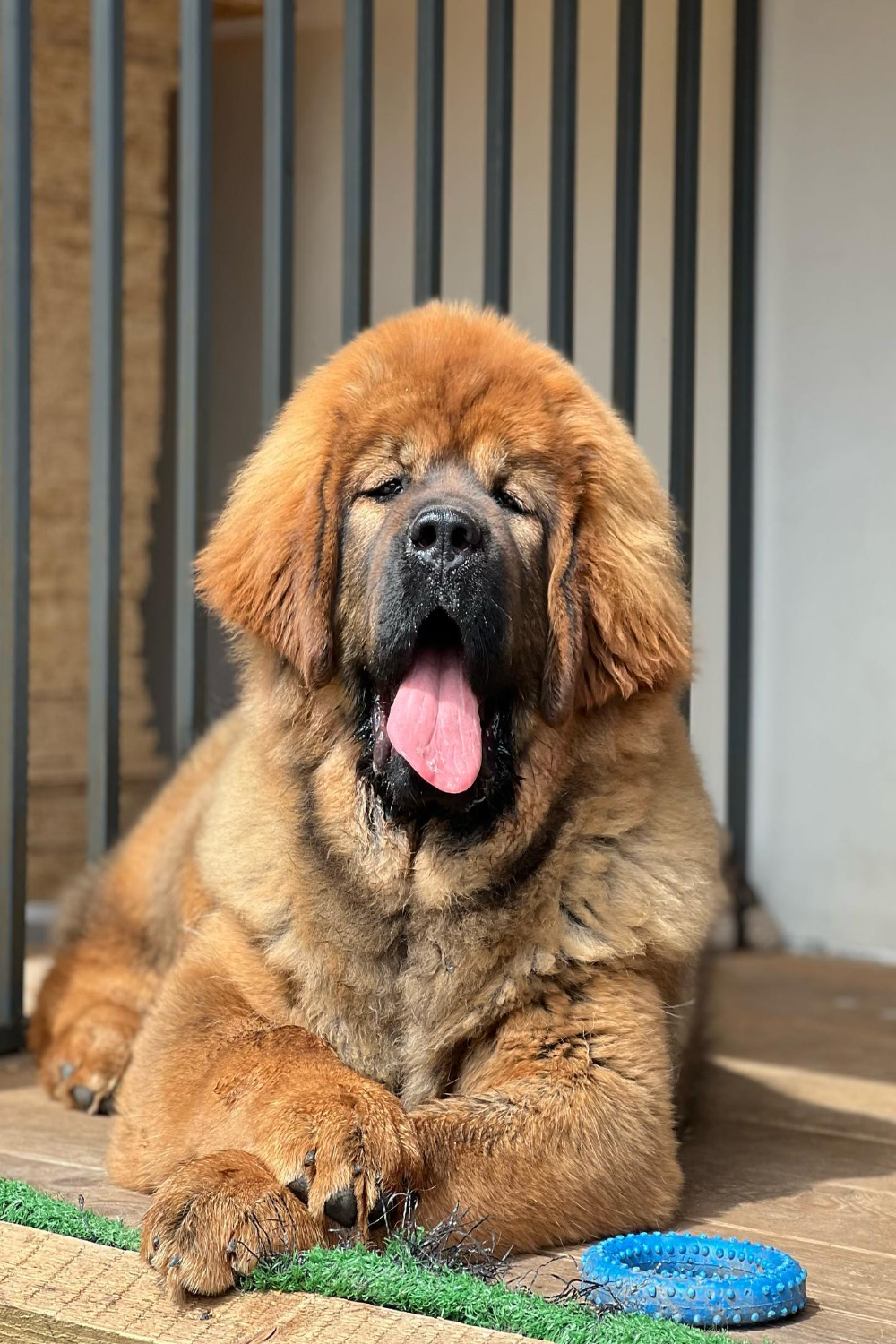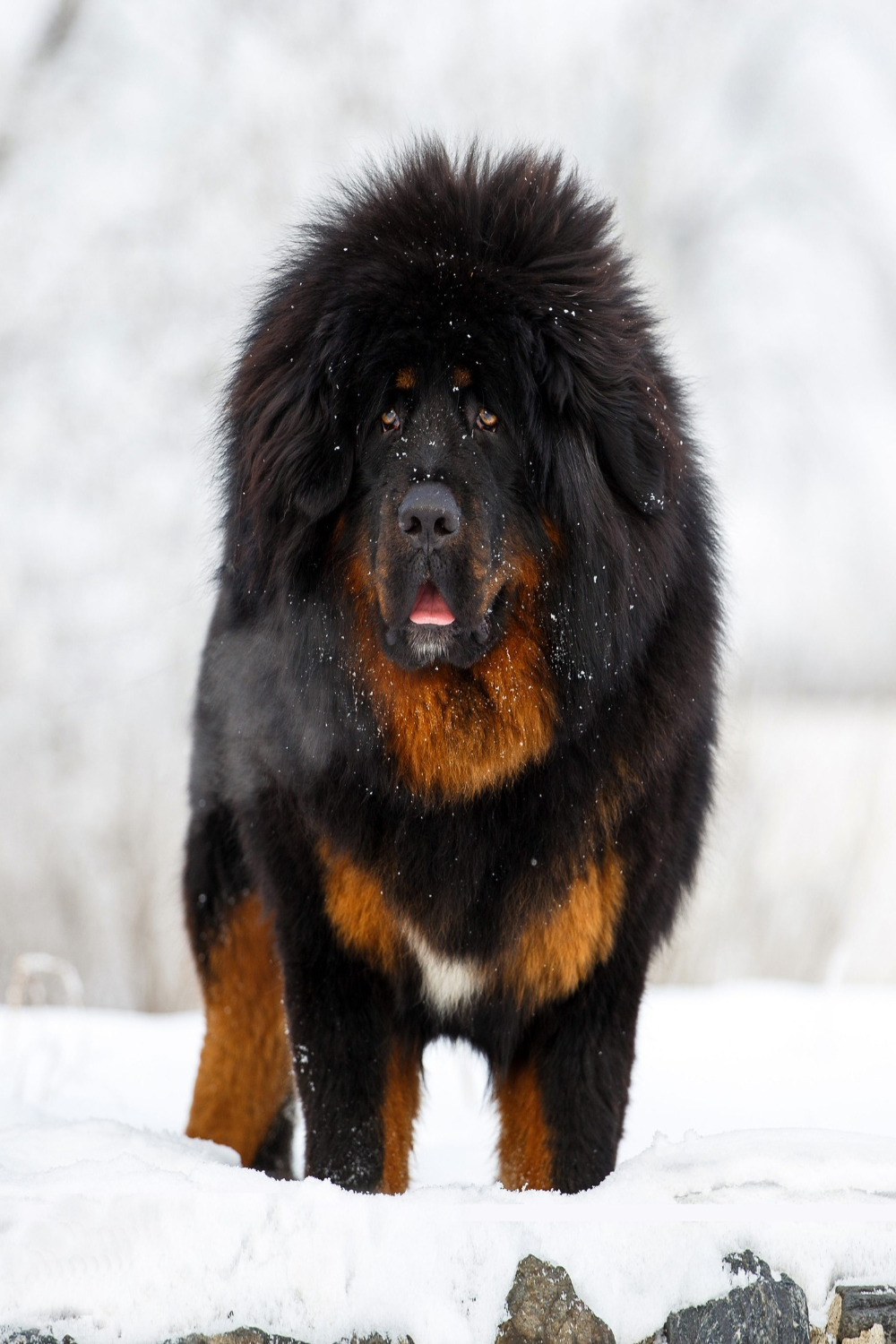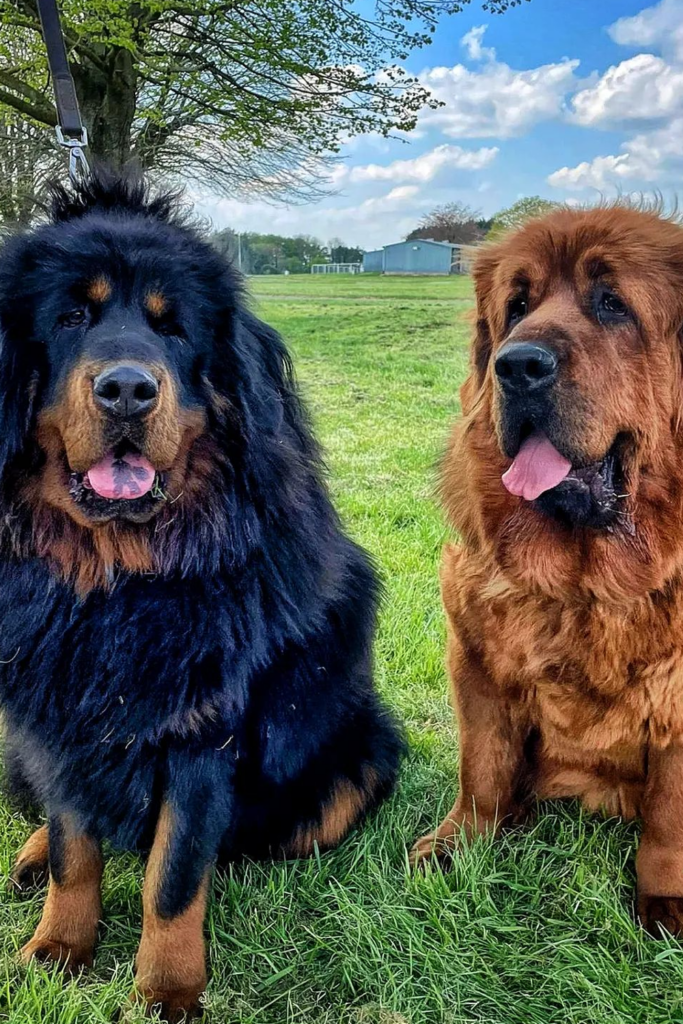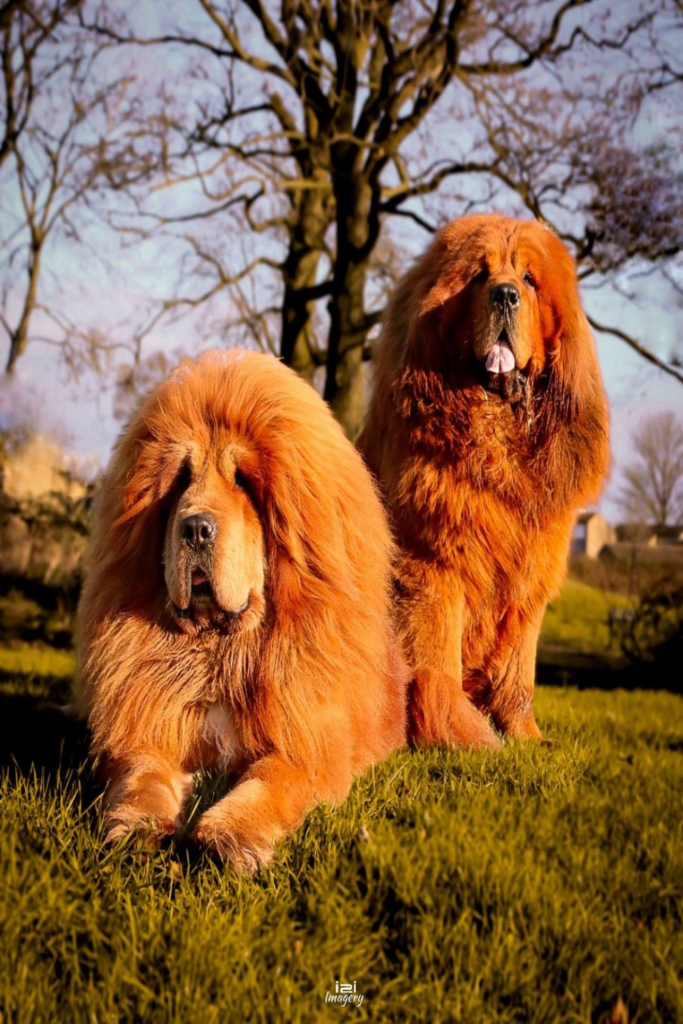We're an affiliate
We hope you love the products we recommend! Just so you know, we may collect a share of sales or other compensation from the links on this page at no additional cost to you. Thank you if you use our links, we really appreciate it!
The Tibetan Mastiff dog breed is a rare mastiff-type towering canine with a strong-willed personality and a flowing lion-like mane.
With origins from the Tibetan region of the Himalayas, this watchful dog breed is often considered one of the most ancient canines in the world today.
Despite their gigantic stature, these lovely pups have a golden heart which makes them extremely loyal to their human caregivers.
Tibetan Mastiffs have an instinct to guard family and property, so they are always wary of strangers and unfamiliar guests.
There’s so much to learn about this titanic dog breed. Keep reading this post to get more insights about Tibetans and gauge if they can be a good addition to your home.
Brief History of Tibetan Mastiffs Dog Breed
The history of Tibetan Mastiffs is not very clear due to scanty historical records about this breed. What we know about the little record available is that the Tibetan Mastiff has been around for thousands of years.
Genetic evidence points out that mastiff-type dogs came from the region of Tibet, and we are almost certain that Tibetan Mastiffs are descendants of those dogs.
These powerfully built canines served as guardians to the Tibetan Buddhist monks, or lamas who inhabited the region.
Before the early 1800s, access to Tibet was restricted for Westerners, resulting in limited knowledge about Tibetan dogs.
Early travelers who visited Tibet rarely mentioned the dogs they came across in their historical travel accounts.

However, in 1800, Captain Samuel Turner documented his experience with gigantic dogs in his work “An Account of an Embassy to the Court of the Teshoo Lama in Tibet.”
Despite this shocking encounter, Turner did not provide a detailed description of the massive dogs.
The first ‘large dog from Tibet’ to be exported from their native region was sent as a gift by Lord Hardinge, Viceroy of India to Queen Victoria in 1847.
The Tibetan Mastiff found their way into the United States over a century later when they first landed in England.
In 1974, The American Tibetan Mastiff Association (ATMA) was formed for the preservation of these towering canines.
It wasn’t until the year 2006 that the American Kennel Club recognized the Tibetan Mastiff as a purebred dog.
5 Facts About Tibetan Mastiffs
1. Tibetan Mastiffs are most active at night
Tibetan Mastiffs have a unique nocturnal behavior that makes them more active under the cover of darkness than during the day.
This habit might have stemmed from their historical protecting roles since they were instinctively on guard during the night.
2. Tibetan Mastiffs are cold-weather warriors
While most dog breeds cannot tolerate chilly weather, these huge Mastiffs from Tibet can endure temperatures of between 45°F and 32°F.

This is possible because of their incredible double coat which keeps them insulated during chilly conditions, allowing them to walk on snow without feeling a pinch.
Despite their endurance, keep in mind that these dogs also have their limits. It’s hazardous to keep your dog out when the temperatures go below 20o F.
3. They are a status symbol in China
Legend has it that both Genghis Khan and Buddha had Tibetan Mastiffs as pets. In recent years, these towering dogs have emerged as a coveted status symbol for China’s affluent elite.
These mastiff-type dogs are very rare outside China and Tibet, making them extra special and highly sought after by the millionaire class of China.
4. Tibetan Mastiff’s puppies mature slowly
While the rate of puppy maturity depends on a variety of factors, the average time it takes between puppyhood and adulthood for most puppies is between 1 – 2 years.
However, Tibetan Mastiff’s male puppies can take anywhere between 4 – 5 years before becoming mature adults, while females reach full maturity within 3 – 4 years.
The slow and steady maturation process of Tibetan Mastiffs is a characteristic of most giant-sized dog breeds.
5. Tibetan Mastiffs are gentle at heart
Despite their imposing size and commanding presence, Tibetan Mastiffs are surprisingly soft-hearted and affectionate with their loved ones.
Underneath their rugged exterior lies a gentle giant and loyal companion who forms deep bonds with those they feel loyal to.
These strong-willed dogs are intelligent and sensitive to their caregiver’s emotions. They will stop at nothing to ensure the safety of your home from strangers.
Tibetan Mastiff Puppies
Before bringing a Tibetan puppy to your home, you should keep in mind that these dogs require a large fenced yard to feel at their best.
Make sure to puppy-proof your home and invest in a variety of essential dog accessories to make a good first impression on your new puppy.
Since Tibetan puppies have a slow maturation process, you should always be patient with them during training and maintain socialization to instill good habits from a tender age.
Tibetan Mastiff Physical Characteristics
Size and weight range
A fully grown Tibetan Mastiff male has a shoulder height of about 26 – 33 inches while their female counterparts are slightly shorter, with a range of 24 – 30 inches.
When it comes to weight, a male adult can tip the scale to the region of 90 – 150 pounds while a healthy female has a range of about 70 – 120 pounds.
Coat Characteristics
The Tibetan Mastiff boasts a dense double coat typified by a long, coarse outer layer and a soft, woolly undercoat.
During warmer months, the undercoat may thin out slightly. The fur is straight and firm, devoid of any curls, waves, or silkiness.
Notably, a substantial heavy mane adorns the neck and shoulders, while the tail and upper thighs feature dense coats and feathering.
Tibetan Mastiff males typically have a more abundant coat than females, often showcasing a thicker mane around the neck and shoulders.
The magnificent luxurious thick coat of Tibetan Mastiffs comes in a variety of color combinations including Black, black-tan, red-gold-sable, brown-chocolate-liver, blue-gray, or gold-yellow.
A few Tibetan Mastiffs may sport small white markings on the chest area and feet but it should be nowhere else on the body.
Distinctive features
Other than their imposing size, the other top distinguishing feature of the Tibetan Mastiff is their large lion-like mane which adds to their regal appearance.
Tibetan Mastiff Temperament and Personality
As a natural guardian, the Tibetan Mastiffs are very smart dogs, and they have a strong desire to protect the people they love.
They might seem a bit stubborn sometimes, but that’s their way of showing how much they care. Because they want to keep you safe, they can be shy or careful around new people.
With the right handler who provides lots of interaction, a Tibetan Mastiff can be an excellent choice to keep at home.
Novice dog owners in a loving home should appreciate the guardian instincts of Tibetans and watch them blossom into calm, cuddly, and incredibly loyal companions.

We however recommend this breed to an experienced owner because they can be strong-willed, protective, and aloof when mishandled.
Tibetan Mastiffs puppies and adults can be like big, fluffy teddy bears with children, especially if raised alongside them.
However, due to their immense size and strong protective instincts, they may not be the best choice for families with young children.
Toddlers can easily be knocked over accidentally, and the dog’s guarding nature could be misconstrued if boisterous play occurs.
Tibetan Mastiff Intelligence
Because of the historical role of thinking independently as guardians for centuries, Tibetan Mastiffs are very intelligent dogs.
These fluffy lion-dogs learn quickly and possess excellent problem-solving skills. However, Tibetan Mastiffs have a strong-willed nature and may sometimes tend to do things on their own terms.
They respond best to patient owners who focus on building a trusting relationship based on positive training methods.
Tibetan Mastiff Average Lifespan
The average Tibetan Mastiff usually lives for about 10-12 years. Of course, some might stick around a little longer while others may unfortunately have a shorter life expectancy depending on individual factors.
When you welcome one of these big pups into your family, you’re making a long-term commitment. They’ll need lots of love, healthy food, exercise, and trips to the vet to keep them happy and strong.
Tibetan Mastiff Dog Breed Health Issues
Tibetan Mastiffs are generally a healthy breed, but just like any other purebreed dog, it’s prudent to be aware of certain health problems they might experience.
When purchasing a TM puppy, it’s best to seek out reputable breeders who prioritize health testing of the parents to minimize inherited conditions. Here are some issues potential owners should know about:
1. Hip and Elbow Dysplasia
These painful joint conditions are common in large dog breeds. Hip dysplasia occurs when the hip joint doesn’t form correctly, while elbow dysplasia is caused by abnormal development of the elbow joint.
2. Hypothyroidism
This condition occurs when the thyroid gland fails to produce enough thyroid hormone, which helps control metabolism. Signs can include lethargy, weight gain, and skin problems.
3. Eye Problems
Tibetan Mastiffs can be prone to eye issues such as Progressive Retinal Atrophy (PRA) – a condition that may impact the dog’s ability to see properly.
4. Canine Inherited Demyelinative Neuropathy (CIDN)
Although rare, some individual TM’s can develop this neurological disorder that affects the covering of nerves leading to weakness and coordination problems.
Preventative Measures for Good Health
Before picking your new puppy, we recommend that you carefully research breeders, looking for those who screen their dogs for common genetic issues that can impact the upcoming pups.
Once you have your dog at home, it’s good to provide them with a balanced diet that contains a generous mix of all essential nutrients and minerals.

Be cautious about overfeeding your dog, because they can add a few extra pounds and put more pressure on their joints.
Plan regular visits to your vet for check-ups to look for any signs of ill health and ensure your Tibetan Mastiff vaccination is up to date.
Tibetan Mastiffs are huge dogs, but they require moderate exercise to keep them in good shape and maintain a healthy weight.
Tibetan Mastiff and Allergies
Despite their massive thick coat, Tibetan Mastiffs don’t shed much throughout most of the year. However, they do have a heavy ‘blowout’ of their undercoat twice a year during fall and spring.
Their dead skin flakes (pet dander) and saliva can still contain allergens, so spending time with the breed before committing is a good idea for people with sensitivities.
Tibetan Mastiff Grooming Needs
Even with such as massive coat, Tibetan Mastiffs are not high maintenance in the grooming department.
Their thick coat puts out negligible fur outside the heavy shedding months, which occur twice a year during seasonal changes.
During the heavy shedding season, daily brushing and regular baths can help keep everything tidy and prevent loose fur from flying everywhere.
Outside the shedding period, the Tibetan Mastiff’s coat can be kept in pristine condition with weekly brushing to prevent mats and tangles.
Check your dog’s ears every week for signs of infections which can manifest in rashes, bad odor, redness, or itchiness.
Dampen a cotton wool ball with a vet-approved ear-cleaning solution and use it to clean through the external part of the dog’s ear canal.
Use a canine-specific toothpaste and a soft toothbrush to brush your dog’s teeth two or three times a week to prevent tartar buildup.
Nail care is super important for dogs. Long nails can be uncomfortable and even make it harder for them to walk properly. Make sure to keep your TM’s nails nicely trimmed and clean for healthy, happy paws.
Tibetan Mastiff Exercise and Activity Levels
Contrary to their gigantic size, Tibetan Mastiffs are surprisingly chill when it comes to physical exertion and exercise.
They need a good walk every day for about one hour to keep them happy and healthy, and they’ll definitely enjoy a play session in a fenced-in yard.

Tibetan Mastiffs are not the type of giant dog who needs extensive physical activity to release pent-up energy.
Never push them beyond their limits, especially in hot weather, because their thick double coats make them prone to overheating.
Importance of mental stimulation
Intelligent dog breeds like Tibetan Mastiffs can get bored easily when they have nothing to do. Providing mentally stimulating activities can redirect destructive behavior such as chewing, digging, or barking.
Brain games offer an outlet for pent-up energy and redirect nervous energy to give your TM a sense of accomplishment. This can make the dog less prone to anxiety and emotional turmoil.
Engaging your dog in collaborative activities like training or playing hide and seek can help make your bond with them even stronger.
Just like in humans, keeping your dog’s brain engaged in constructive activities can help decline the early onset of cognitive disorder.
Tibetan Mastiff Training and Socialization
These big fluff balls can be super smart but they need consistent, positive training from an early age to shape their strong-willed attitude.
It’s also important to start socializing your pup right from puppyhood into adult life. Let your young Mastiff meet with various people, places, and other dogs in a controlled way.
Social training is important because it teaches your dog how to behave in different situations and also exposes the fun aspects of life.
Tibetan Mastiff Living Conditions
Due to their massive size, the Tibetan Mastiff will be contented in a home with enough indoor and outdoor space to live in comfort.
A fenced home with enough yard space to roam and play will satisfy your Tibetan Mastiff’s needs because they can freely roam and exercise on their own.
Places with hot, humid climates are unsuitable for this companion dog because of their heavy coat. During the summer, it’s essential to keep your TM cooled and offer plenty of water when outdoors.
Tibetan Mastiff Diet & Nutrition
Despite being huge, many Tibetan Mastiffs don’t have the big appetite to consume too much food like other giant breeds.
Some individual Tibetan Mastiffs can even go for days without eating, so it’s always important to ensure they take in the recommended portion size.
If your Tibetan Mastiff has a big appetite for food, you need to check on their consumption to ensure they don’t ingest too much to the risk of obesity.
Provide good quality well-balanced food for your Tibetan Mastiff, especially those formulated for large or giant breeds.
Big dogs are at a higher risk of developing joint-related issues, so you can ask your vet about the possibility of adding dog supplements to your Tibetan Mastiff’s diet.
Tibetan Mastiff Pregnancy & Litter Size
Owing to their large stature, female Tibetan Mastiffs take their time before they are ready to become moms, often at around 18 – 24 months of age.
The average gestation period of Tibetan Mastiffs is about 63 days, and when they have puppies, the litter size can vary from anywhere between 5 – 12 little pups.
Conclusion
There you have it guys – our comprehensive information about the Tibetan Mastiff dog breed. These giant fluffs are impressive with much less exercise needs compared to other large breeds.
If you love the idea of a protector, a cuddle buddy who doubles as a teddy bear, and are ready to learn from a dog with a strong-willed attitude, then a Tibetan Mastiff might be a great fit.
Laura is the founder of Furs'n'Paws. She is a also a pet writer and expert with more than 20 years of experience of working with dogs and cats. She developed a very strong love for animals at a young age. Her passion led her to establish a thriving pet sitting and dog walking business in Dubai. As an expert in pet training, behavior, and nutrition, Laura is committed to helping pet owners and pet lovers by offering high-quality information on a wide range of topics.



No responses yet